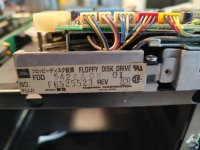Andrew Baker
Experienced Member
- Joined
- Mar 6, 2022
- Messages
- 59
I have a kaypro XT with two toshiba floppy drives (see photo for label) i can find no documentation for them.
the main issue is that both will intermittently not work, both at the same time i think?. when they do work drive A will read the directory but if i try to run something i get "sector not found reading drive A" the heads seem to move back and forth as if looking for something, head issues maybe? Drive B works just fine. I swapped the drives top to bottom and the problem follows the drive.
both drives have been serviced and are mechanically working fine. i was very careful cleaning the heads but i suppose i could have misaligned one. how can physically electrically test the heads, and check the alignment of them?
I have no idea what causes the intermittent fault, when that happens I just get "general failure reading drive" or "drive not ready". they started working again after using a cleaning disk and swapping the floppy cabe for the original one that worked before.
maybe just a dodgy connection for the intermittent problem?

the main issue is that both will intermittently not work, both at the same time i think?. when they do work drive A will read the directory but if i try to run something i get "sector not found reading drive A" the heads seem to move back and forth as if looking for something, head issues maybe? Drive B works just fine. I swapped the drives top to bottom and the problem follows the drive.
both drives have been serviced and are mechanically working fine. i was very careful cleaning the heads but i suppose i could have misaligned one. how can physically electrically test the heads, and check the alignment of them?
I have no idea what causes the intermittent fault, when that happens I just get "general failure reading drive" or "drive not ready". they started working again after using a cleaning disk and swapping the floppy cabe for the original one that worked before.
maybe just a dodgy connection for the intermittent problem?

